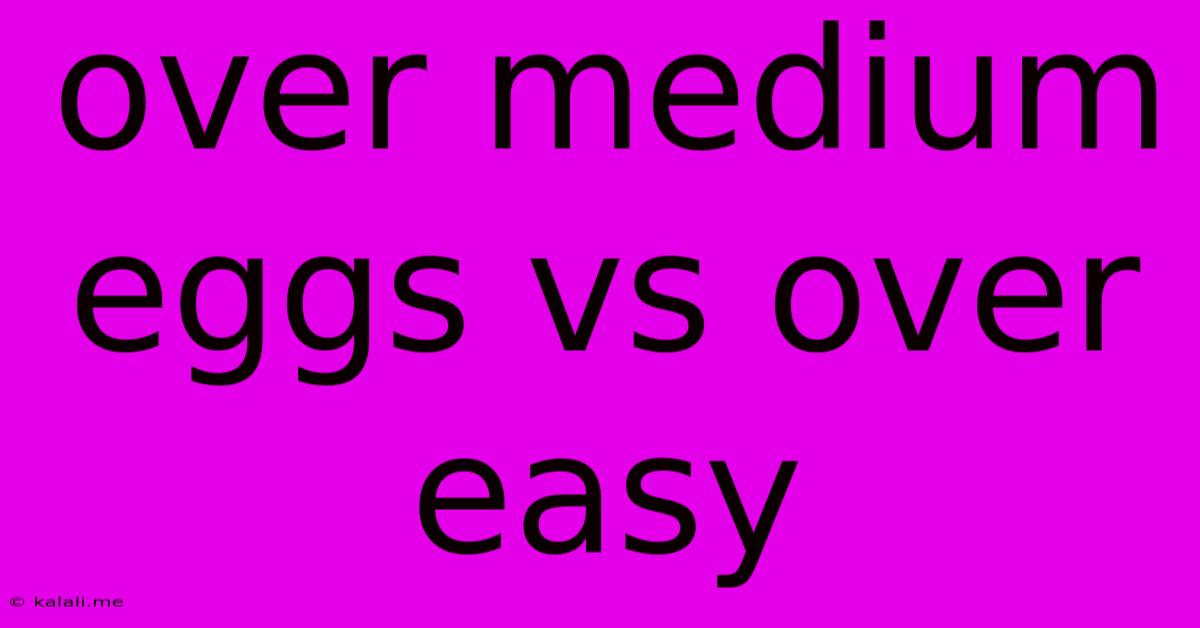Over Medium Eggs Vs Over Easy
Kalali
Jun 03, 2025 · 3 min read

Table of Contents
Over Medium vs. Over Easy Eggs: The Ultimate Showdown
Choosing between over medium and over easy eggs might seem trivial, but for egg aficionados, it's a matter of serious culinary debate. This article dives deep into the differences between these two popular cooking methods, helping you decide which perfectly cooked egg best suits your palate and cooking style. Ultimately, the "best" method depends entirely on personal preference, but understanding the nuances will elevate your breakfast game.
What's the Difference?
The key difference between over medium and over easy eggs lies in the degree of yolk coagulation. Both methods involve frying eggs until the whites are set, but the yolks are treated differently.
- Over Easy: The egg is flipped briefly, just enough to set the bottom of the white. The yolk remains completely runny.
- Over Medium: The egg is flipped and cooked a bit longer, resulting in a yolk that is still runny but slightly more set around the edges. Think of it as a happy medium between over easy and over hard.
Texture and Taste Considerations:
The cooking time directly impacts the texture and taste.
- Over Easy: Offers the runniest, most luxurious yolk, perfect for dipping toast or enjoying the rich, uncooked center. The whites are tender and slightly soft.
- Over Medium: Provides a slightly firmer yolk, still runny but less likely to burst. The whites are fully set, offering a firmer texture. The yolk offers a slightly richer flavor due to a longer cooking time.
Visual Differences:
The visual difference is subtle yet noticeable:
- Over Easy: The yolk is completely liquid and vibrantly colored, almost glossy. The white is fully cooked but the edges might be slightly irregular.
- Over Medium: The yolk is still liquid, but a thin layer around the edge will have begun to solidify, resulting in a slightly paler hue around the periphery. The whites are completely opaque and cooked through.
Cooking Techniques:
Both methods require low-to-medium heat to prevent burning. A non-stick pan is recommended for easy flipping and preventing sticking.
- Butter or Oil: Use a small amount of butter or oil to prevent sticking.
- Low Heat: Low heat allows the whites to cook evenly and prevents the yolk from becoming overcooked.
- Flipping: Use a spatula to gently flip the egg. For over easy, a quick flip is all that's necessary. For over medium, cook for a few more seconds after flipping.
Which One Should You Choose?
The best choice depends on your preferences:
- Choose Over Easy if: You prefer a completely runny yolk, a luxuriously rich taste, and a slightly softer texture. It's perfect for dipping bread or enjoying a truly decadent breakfast.
- Choose Over Medium if: You prefer a slightly firmer yolk that is less likely to break, but still maintains a runny center. This option provides a balance between runny yolk and fully cooked whites.
Ultimately, experimenting with both methods is the best way to determine your personal preference. Don't be afraid to play with cooking time to achieve your desired level of yolk doneness. Happy cooking!
Latest Posts
Latest Posts
-
How To Remove Mirror Glued To Wall
Jun 05, 2025
-
Ghost In The Shell The Major
Jun 05, 2025
-
Do You Capitalize The First Word In A Quote
Jun 05, 2025
-
Get Odds Ratio From Glm In R
Jun 05, 2025
-
How To Remove Mud Dauber Nest
Jun 05, 2025
Related Post
Thank you for visiting our website which covers about Over Medium Eggs Vs Over Easy . We hope the information provided has been useful to you. Feel free to contact us if you have any questions or need further assistance. See you next time and don't miss to bookmark.